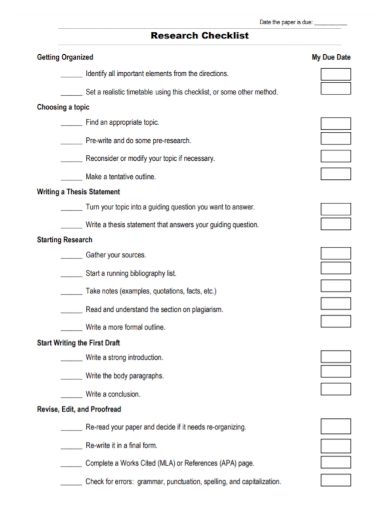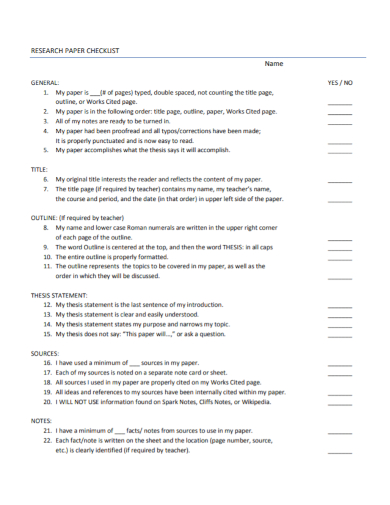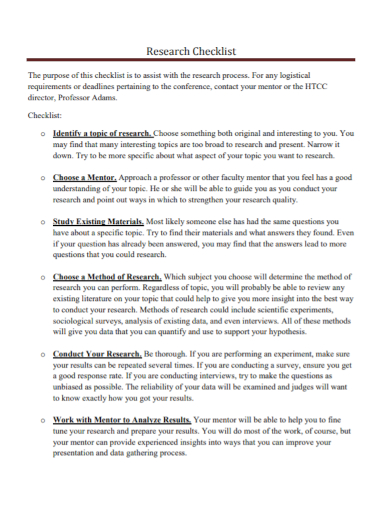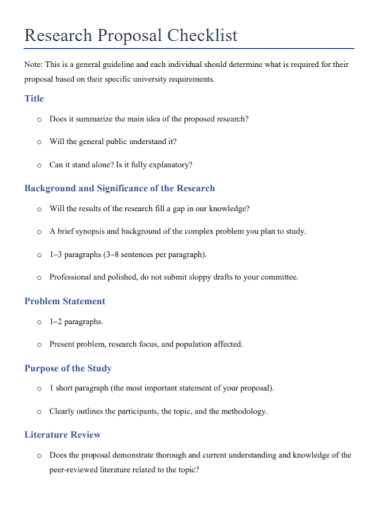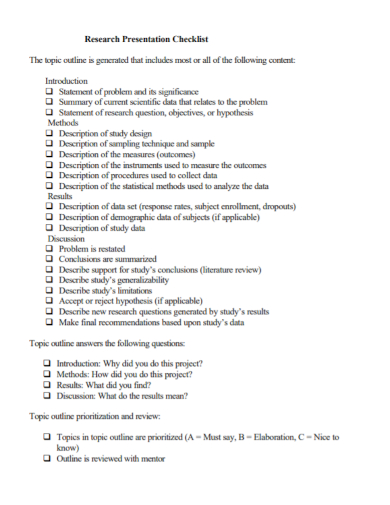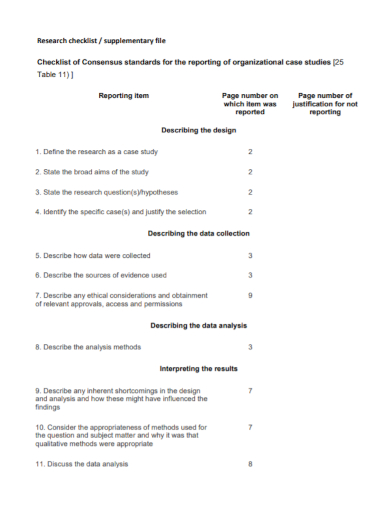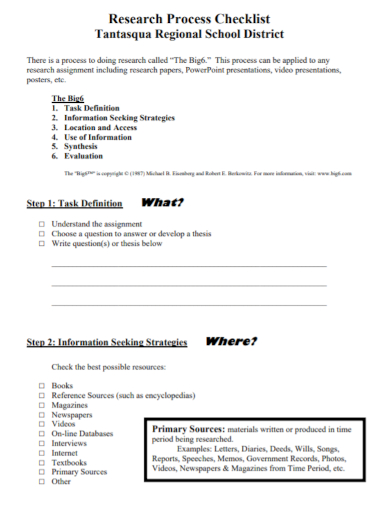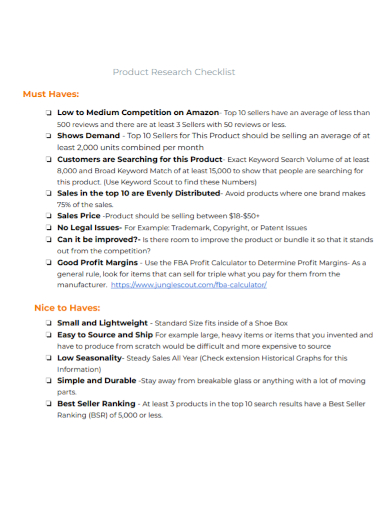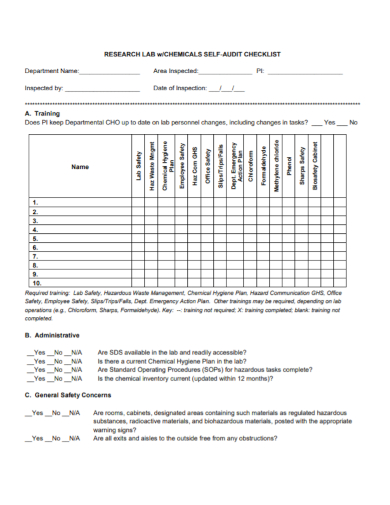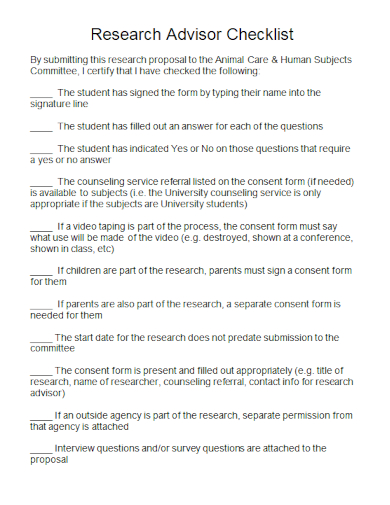Research is always a part of life. Whether if it’s done for academic purposes or done in an industry-related setting, research is conducted with the purpose of discovering a new study, gathering new information about a certain topic, or testing a theory. Either way, research is a big deal, especially for students who need to conduct it in order to finish their degree or for industries to make a major breakthrough that radicalized their whole perspective. Since doing research is highly crucial, there are a lot of particular steps to follow and certain things to do. But with so many of these things to do, you are bound to forget some steps. To help keep track of those, you need a checklist to guide you in doing your research. Read the article to find out how to make a research checklist.
10+ Research Checklist Samples
1. University Research Checklist Template
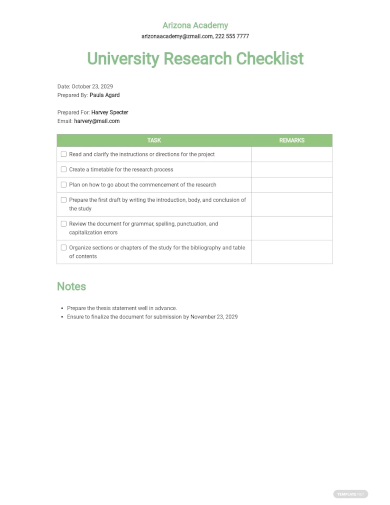
2. Research Checklist
3. Research Paper Checklist
4. Sample Research Checklist
5. Research Proposal Checklist
6. Research Presentation Checklist
7. Supplementary Research Checklist
8. Research Process Checklist
9. Product Research Checklist
10. Research Laboratory Audit Checklist
11. Research Advisor Checklist
Importance of a Research Checklist
Research checklists are especially useful for researchers as a tool to verify that all the research process to be done will be completed by the researcher. The checklist is especially crucial during data collection through writing the research report.
How to Make a Research Checklist
To make a checklist, use a sheet of paper and a pen to list down all the steps of the research process that you need to do. The following steps below are guidelines on what to put in your checklist:
1. Identify a Topic for Research
First, choose a research topic that is something both original and interesting to you. If your desired topic is too broad to research, narrow it down. Be more specific about what aspect of your chosen topic you want to research. To help you choose a specific topic, ask yourself some questions to construct your information needs. Once you’re done with those, you will then draft a statement of purpose for your research.
2. Choose a Mentor
The next step to include in your checklist is having a mentor to guide you in your research. Research is a difficult thing to do especially if you’re doing it alone and have zero ideas on how to conduct it properly. So having someone who has a good understanding of your topic to help you, such as your professor or a faculty member is a big help for you to progress in your research and strengthen its quality.
3. Locate Useful Resources
Of course, you can’t forget the next step which is to gather all sources of information that are useful for your topic. You can find a lot of information in a variety of formats such as books, encyclopedias, databases, websites, periodicals, interviews, etc. With a lot of information out there, it can likely send you into an information overload. Remember to only select the most useful resources by matching them to information your needs. A pro tip for better resources is to look for a primary source to make your research more interesting. Primary sources include photographs, speeches from prominent people, historic documents, etc.
4. Choose a Method of Research
The next part to include in your checklist is to decide what method is the best way to conduct your research. The clue to knowing what research method you will be performing is already knowing your topic. Methods of research could include scientific experiments, sociological surveys, analysis of existing data, and conducting interviews with respondents. Write down the methods you have identified that suit perfectly your topic and in answering your problem or trying out your hypothesis.
5. Compile All Your Sources
Your research checklist won’t be complete without keeping track of your sources. Compile all your research questions, such as summarizing, paraphrasing, and taking down direct quotes from primary sources. Don’t forget to cite your sources as you use them to save time when you make a bibliography.
5. Synthesize your research
The next part of the checklist is to determine the appropriate order or structure to present your data analysis and its results. Know how to provide your insights through your presentation of your data gathering process.
7. Share what you learned
And lastly, include a mini self-evaluation sub-checklist to track your progress until you complete your research. This will help you list down all the things you did and discovered in your research, and prepare to answer questions you could be asked during your presentation.
FAQs
What are the 5 methods of collecting data?
The five methods of collecting data are interviews, questionnaires, surveys, observations, obtaining documents, and records.
What are some research methods?
Research methods are defined as tools that a researcher uses to do research. These research methods are qualitative, quantitative, or mixed.
What are the 4 types of research design?
There are a lot of research designs however the following are the research designs that are usually used by researchers: general structure and writing style, descriptive design, experimental design, action research design, cross-sectional design, case study design, and causal design.
When you’re done drafting your checklist, make sure to review and revise it when necessary. Consult with your mentor to see your checklist just to make sure you didn’t miss anything. Take note that even though you may complete your checklist during the initial phase of your research, you are likely to make changes with it so add room for additional information that you may take down on your checklist. If you feel like making your own checklist today, download our free sample templates provided above!
Related Posts
FREE 10+ Group Proposal Samples
FREE 54+ Questionnaire Samples
FREE 13+ Compliance Checklist Samples
FREE 10+ Research Data Collection Form Samples
The Essential Content Marketing Checklist for Small Business
FREE 10+ Investigation Checklist Samples
FREE 10+ Marketing Checklist Samples
FREE 7+ Sample Project Evaluation
FREE 6+ Sample MS Word Checklist
FREE 21+ Student Checklist Samples
FREE 12+ Observation Checklist Samples
FREE 10+ Research Meeting Minutes Samples
FREE 10+ Research Implementation Plan Samples
FREE 10+ Scientific Research Proposal Samples
FREE 19+ Quality Checklist Samples

